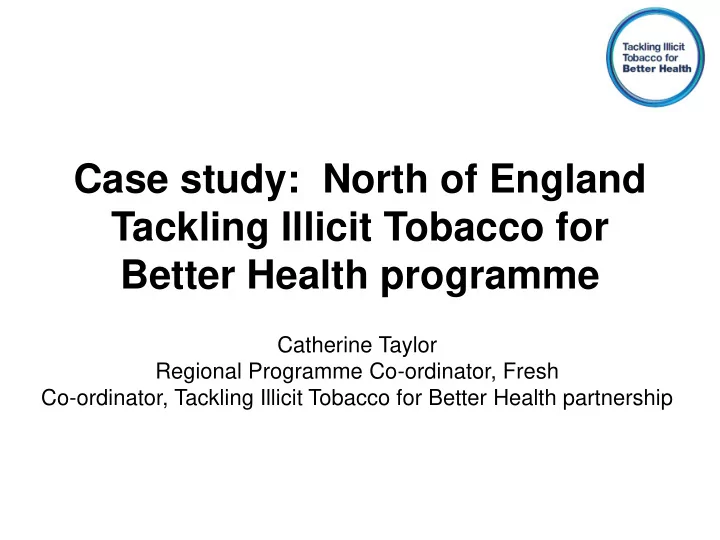

Case study: North of England Tackling Illicit Tobacco for Better Health programme Catherine Taylor Regional Programme Co-ordinator, Fresh Co-ordinator, Tackling Illicit Tobacco for Better Health partnership
What we’ll cover 1. Overview to the NoE programme 2. Developing partnerships 3. Getting to know our audience 4. Intelligence and enforcement 5. Marketing and communications 6. Results 7. Challenges, conclusions and recommendations
North of England Tackling Illicit Tobacco for Better Health A world-first programme Part of broader tobacco control Aims: • To reduce the supply of illicit tobacco • To reduce the demand for illicit tobacco Multi-agency summit 2007 Launched in 2009
NoE programme scope and partners Key partners Fresh Tobacco Free Futures Smokefree Yorkshire and Humber Department of Health HM Revenue and Customs Local authority regulatory services Trading Standards regional intelligence teams Public Health teams Police National Health Service 2013: Collaboration with Smokefree South West
‘Reasons to care’
Getting to know our audience 2009: large scale public opinion survey across North East, North West and Yorkshire and the Humber 6,000+ interviews, smokers, non-smokers, adults and young people
Key results 2009 20% smokers bought illicit tobacco More likely to be young male buyers and sellers On average illicit buyers smoked 2 more cigarettes a day than non illicit smokers 64% of buyers said illicit tobacco ‘ makes it possible to smoke when I could not afford to otherwise ’ Around 25 % would report trade, but rose to 75% ‘if selling to children’ Available from different sources and locations
Intelligence and enforcement Enhanced regional Trading Standards capacity Strategic prioritisation Sharing and coordination of intelligence Joint mapping of markets and coordinated enforcement activity Increased intelligence and enforcement mapped to marketing activity
Marketing and communications 2010 Phase One: ‘Get Some Answers’ Based on insight Tested messages with the public Key message: protecting children Find out more at www.get-some- answers.co.uk Call Crimestoppers
Post-campaign results 2010/11 Campaign evaluation + survey repeat • Public more aware – and supportive – of efforts to tackle illicit tobacco • More likely to reports sales to children • Increased proportion of people ‘very uncomfortable’ with illicit tobacco • Fewer people buying, and buying less • 23% reduction in volume of illicit market
Marketing and communications 2011/12 Phase Two: Keep It Out Built on post-campaign results Key message: protect children and report Call Crimestoppers Visit www.keep-it- out.co.uk
Ongoing public relations
Highlighted as best practice • UK Centre for Tobacco Control Studies “ The programme offers an exemplar of partnership working which has shown great promise in terms of finding impactful consumer messages about the harmfulness of illicit tobacco to communities, raising awareness of the issue, increasing intelligence and changing behaviours and therefore deserves to be widely disseminated .” • All Party Parliamentary Group on Smoking and Health inquiry into illicit tobacco • National Audit Office report on tobacco smuggling • Public Accounts Committee report on tobacco smuggling • HM Revenue and Customs tobacco smuggling strategy • HM Government’s tobacco control plan for England
Latest insight 2013 1,500 surveys across North East of England Since 2009: • Smokers buying illicit tobacco: 24% down to 17% • Illicit tobacco market share: 15% down to 11% Reductions in: • Smoking prevalence • Proportion of smokers being offered • Levels of comfort with illicit tobacco • Perception of illicit buying as a social norm Increase in: • Likelihood of reporting, especially if selling to children
Challenges, conclusions, recommendations Effective approaches are those which: - Reduce the demand for and the supply of illicit tobacco - Work across geographical boundaries - Are co-ordinated between agencies - Are placed within broader tobacco control strategies - Protect activity from the interests of the tobacco industry
Challenges, conclusions, recommendations The tobacco industry: - Exaggerating the size of the market - Opposing effective regulation - Complicit in oversupply - Claiming ‘quality’ of their product
Challenges, conclusions, recommendations Need to: Sustain strategic partnerships Continue monitoring the illicit tobacco market Continue focus on broad tobacco control Protect activity from industry interference Consider options for further regulation e.g. licensing of retailers
Thank you Any questions? Catherine Taylor Tackling Illicit Tobacco for Better Health catherine.taylor@freshne.com www.illicittobacconorth.org www.keep-it-out.co.uk
Recommend
More recommend